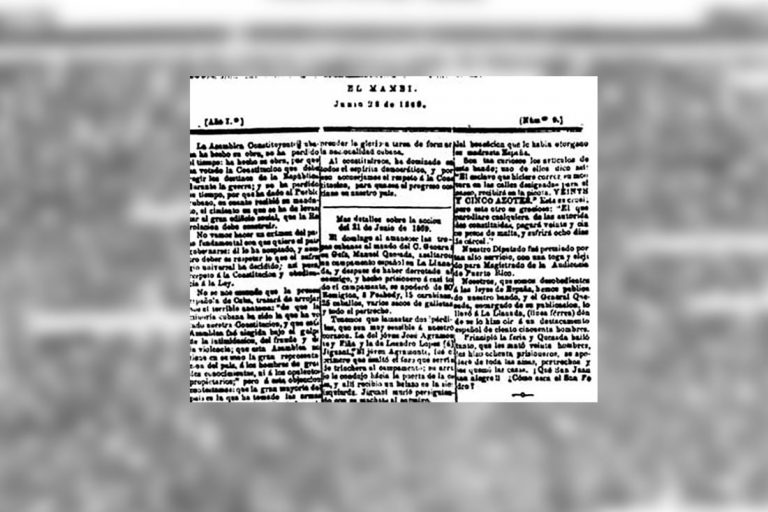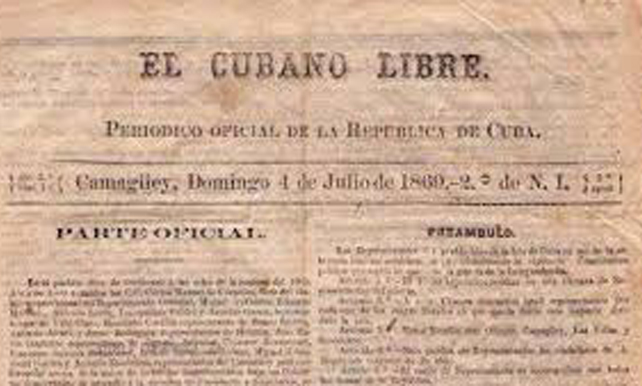In the sacred town of Guáimaro, the newspaper El Mambí was born, on May 7th, 1869, under the auspices of the patriots Ignacio Mora de la Pera and Ana Betancourt Agramonte.
A halo of astonishment surrounds those who listen to the stories of the liberating feat of 1868-1878, in Camagüey. The courage of men and women to fight the Spanish army was combined with the most distinguished features of the city culture, theater gatherings, literature, music -that is why it is not surprising the presence of a piano in the battlefield-, and even the printing of a mambí newspaper.
In the region there were approximately 223 newspapers from 1810 to 1899, some very ephemeral, others with a longer duration, scope and importance to communicate political, cultural, economic issues, among others; El Fanal and La Gaceta de Puerto Príncipe consolidated themselves beyond city life.
The insurrectionary press had more than twenty newspapers during the independence exploits. In Camagüey, several were published, among them: El Cubano Libre, the first publication of its kind on the island, which was born in Bayamo on October 17th, 1868, then was printed in our plains from July 4th of the same year until 1871, when Spanish forces destroy their facilities in a Florida hamlet.
In the same way, in the sacred town of Guáimaro, the newspaper El Mambí was published on May 7th, 1869, created by the couple of Ignacio Mora de la Pera and Ana Betancourt y Agramonte, who were assisted by Clodomiro Betancourt, also a collaborator of the Cubano Libre. They used the Libertad printing press brought to the town for these purposes and began to edit the newspaper. His name was a reaffirmation of rebellion.
What circumstances marked this publication?
Unquestionably, its birth in the days after the Guáimaro Assembly filled with patriotic effervescence not only the inhabitants of the region, a factor used by Mora and Ana, to communicate what was happening in the redemptive battlefield and other topics of interest of the fight that just started.
On the other hand, the patriots aspired to turn the publication into the official body of the nascent Government of the Republic in Arms, although this desire did not come tru El Mambí rendered great services to the Homeland until June 26th, 1879.
His controversial and rebellious voice against the criteria of the detractors of the Revolution or Spanishizing ideas won him numerous followers.
Its structure
It consisted of 4 sheets, with three columns. Carlos Manuel de Céspedes, Manuel de Quesada, Ignacio Mora and other patriots collaborated in its pages.
Some scholars affirm that it had only one edition in Guáimaro, the researcher Desiderio Borroto Fernández refers that Ibrahím Hidalgo recognizes the publication of three numbers until May 10th, when the Guaimarenses burn the city before the advance of the Spanish army towards the area.
Circumstances forced to move the printing press to the redemptive battlefield, and there, despite the complex conditions for the manual elaboration of its editions, up to 300 copies were printed, Ana Betancourt served as a clerk and at the same time distributed it for free to emigrants, urban areas and the battlefield through the famous mambí mail.
Present and legacy
Currently in the National Historical Archive, some copies are preserved. It is the newspaper El Mambí, the pride of those who were born in this insurgent land of Camagüey, or of those who simply settled here and feel it as their own; for Guáimaro, it also constitutes the birth of the periodical press in his city.
Translated by: Aileen Álvarez García







